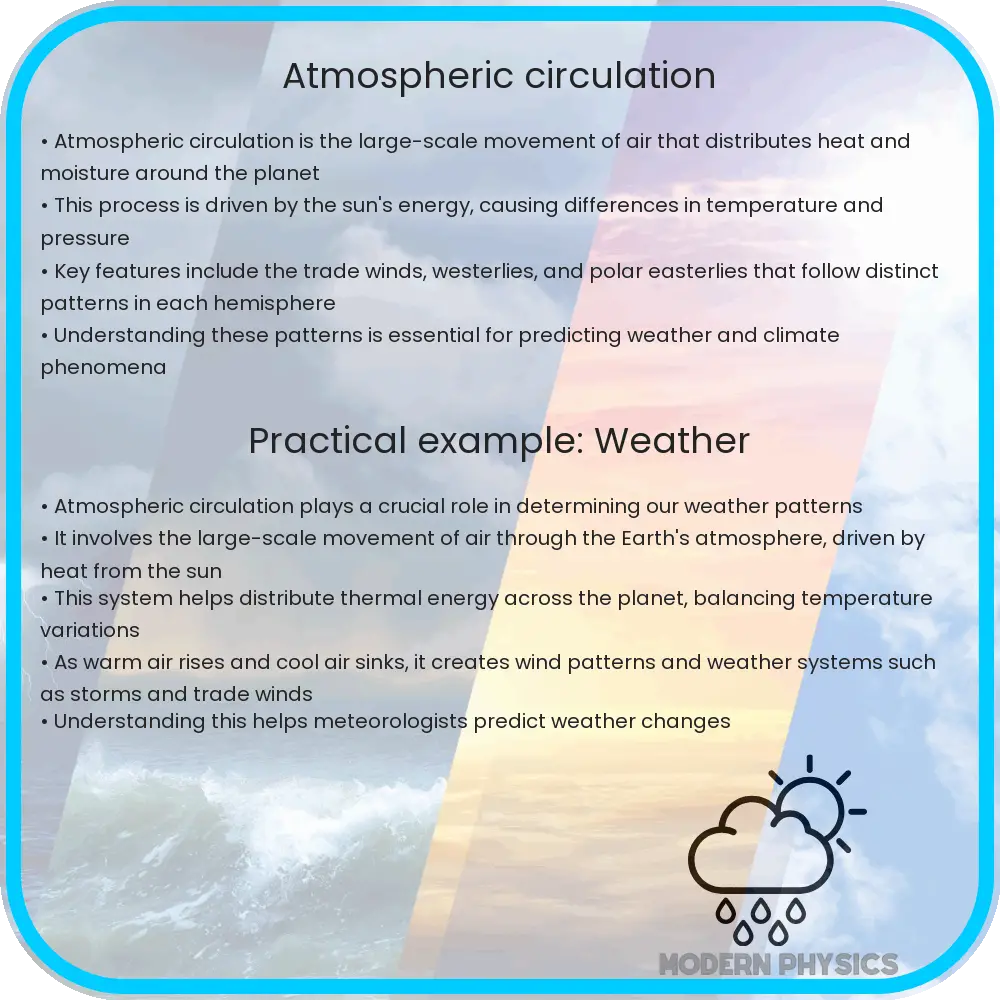Learn how atmospheric circulation, driven by solar energy and Earth’s rotation, influences global weather and climate through wind patterns and air mass movements.

Understanding Atmospheric Circulation
Atmospheric circulation is a key concept in meteorology that describes the large-scale movement of air that helps distribute thermal energy (heat) across the surface of the Earth. This movement is not random but follows very specific patterns which are primarily influenced by the Earth’s rotation, the position of the sun, and the properties of air masses. Understanding these patterns is crucial for grasping how weather conditions and climate dynamics operate globally.
The Drivers of Atmospheric Circulation
The primary driver of atmospheric circulation is solar energy. The sun heats the Earth’s surface unevenly due to variations in surface characteristics, and the angle at which its rays hit different latitudes. Equatorial regions receive more direct sunlight and are generally warmer compared to the poles, which get less solar exposure. This temperature difference creates a balance-seeking movement of air from high to low temperature areas, manifesting as wind.
However, the rotation of the Earth complicates this straightforward movement. Due to the Coriolis effect, wind paths curve as they travel. In the northern hemisphere, this deflection is to the right, while in the southern hemisphere, it’s to the left. This effect is responsible for the swirling wind patterns seen in cyclones and anticyclones.
Major Wind Patterns
Global wind patterns are categorized into three primary belts in each hemisphere:
- Trade Winds: These are warm, steady breezes that originate from the subtropics and blow towards the equator. Generally found between 30° latitude north and south, these winds are crucial in navigating the oceans historically.
- Westerlies: Located between 30° and 60° latitude, these winds move from the southwest to northeast in the northern hemisphere, and from the northwest to southeast in the southern hemisphere. They influence the weather patterns of many mid-latitude countries.
- Polar Easterlies: These are cold, dry winds blowing from the east to the west and are found between 60° latitude and the poles. These winds arise due to high-pressure systems over the poles.
The interface between these wind belts, particularly where trade winds meet, gives rise to a region known as the Intertropical Convergence Zone (ITCZ). This zone is noted for its precipitation patterns, which significantly influence climate in tropic regions.
Cellular Structure of Atmospheric Circulation
The atmosphere is divided into circulation cells that help describe the movement of the vast air masses and predict weather patterns:
- Hadley Cells: These cells exist between the equator and 30° latitude north and south. Warm air rises at the equator, moves towards the poles at high altitude, cools down, and sinks at about 30° latitude. This cycle creates stable weather and steady winds.
- Ferrel Cells: Located between 30° and 60° latitudes, these cells circulate air in the opposite direction to Hadley Cells. Here, air flows poleward and eastward near the surface and returns equatorward and westward at higher altitudes.
- Polar Cells: These are found from 60° latitudes to the poles. Cold dense air sinks and spreads southward, warming as it is forced to rise again.
This tri-cellular model simplifies the complex mechanisms of atmospheric movements but is effective in illustrating the general pattern of air circulation across the globe, contributing significantly to both regional and global climate dynamics.
Impact of Atmospheric Circulation on Weather and Climate
The patterns of atmospheric circulation are central to forecasting weather and understanding climate variations. For instance, the shift in location and strength of the Intertropical Convergence Zone (ITCZ) over the seasons leads to the dramatic swings in weather experienced in tropical regions, from dry spells to heavy rains.
Similarly, anomalies in these circulation patterns, such as El Niño and La Niña, result from deviations in the sea-surface temperatures in the Pacific Ocean. These phenomena affect the positions of jet streams and wind belts, causing widespread impacts on global weather patterns, including changes in precipitation and temperature distributions.
Human Impact on Atmospheric Circulation
Human activities, especially the emission of greenhouse gases, are having an increasing influence on atmospheric circulation. These emissions not only lead to global warming but also are suspected to affect the strength and pattern of the planetary wind systems.
For example, the melting of polar ice caps due to global warming could weaken the polar cells, altering wind patterns and potentially leading to more extreme weather events globally. This linkage highlights the importance of environmental policies and sustainable practices to mitigate impacts on the Earth’s climate system.
Conclusion
The intricate dance of winds across the planet, driven by solar energy and the Earth’s rotation, forms an essential component of our planet’s climate system. By comprehending the fundamental principles behind atmospheric circulation, such as the interaction of wind belts and the Coriolis effect, we gain insights into the dynamics of weather patterns and climate change. The understanding of these processes not only aids scientific communities but also informs policy-making and helps in effective climate adaptation and mitigation strategies.
Indeed, as we continue to explore and understand these dynamic systems, the role of accurate prediction and environmental stewardship becomes ever more critical in preserving the delicate balance of our planet’s atmosphere.
